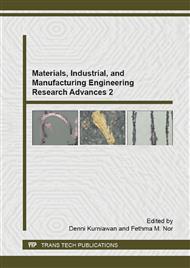p.131
p.136
p.143
p.148
p.152
p.157
p.161
p.166
p.171
Parameter Design for Hardness of Metal Filled Epoxy Matrix
Abstract:
Epoxy is blended with metal fillers to enhance its performance and application for tooling. Material used contains aluminium particles (Rencast CW47), blended with brass separately. Brass is added into the matrix based on 10%, 20% and 30% of the epoxy mix weight ratio. Using Taguchi method, controls factor such as pre-curing temperature (A), filler percentage (B), degassing time (C), curing time (D) and post curing temperature (E) are selected parameters in order to determine optimum conditions. Noise strategy is adopted for material cooling via ambient (N1) and oven temperatures (N2), which gave different hardness values of the epoxy composite. Optimum parameters were decided based on the prediction of S/N ratio, where A = Room temperature, B = 20%, C = 60 minutes, D = 14 hours and E = 1800C. The most significant control factor is de-gassing time for both fillers, and percentage of filler to weight ratio of epoxy mixture is optimum at 20%. It was found that brass gave higher mean hardness values, (Hv = 24.1) compared to copper (Hv = 22.7) and aluminium filled epoxy (Hv = 22.3) based on the prediction run, and suitable as additional filler to improve the surface toughness of epoxy matrix as inserts. Confirmation run was conducted according to the optimum parameters and validated the gain values for brass at 7.98. Fillers enhance the mechanical properties of epoxy matrix by increasing hardness of mould cavity and core. This work helped to design the best control factors to produce optimum hardness conditions for filled epoxy matrix.
Info:
Periodical:
Pages:
152-156
Citation:
Online since:
October 2015
Keywords:
Price:
Сopyright:
© 2015 Trans Tech Publications Ltd. All Rights Reserved
Share:
Citation:


